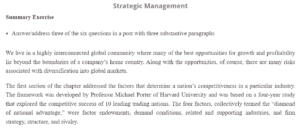Student’s Name
Instructor’s Name
Course
Date
Strategic Management
What are the advantages and disadvantages of the three types of boundaryless organizations: barrier-free, modular, and virtual?
Barrier-free organizations bridge the cultural and functional variations in finding common grounds that promote information sharing and other forms of cooperative behavior. The advantages include leveraging employees’ talents, promoting cooperation and information sharing, and obtaining a faster market response (Dess, 2013). The drawbacks include the lack of trust, which adversely affects performance, challenges in overcoming the political boundaries outside the organization, the non-existence of strong leadership, and common vision that adversely affects coordination.
Over time, domestic processes prove to be time-consuming. Modular organization entails the outsourcing of non-vital functions. The advantages include attaining best-in-class performance, information sharing, and strategic control over activities. The disadvantages include reduced operational management and erosion of cross-functional skills (Dess, 2013). Virtual organizations refer to firms that leverage resources and exploit opportunities in the external environment. The advantages include sharing skillsets and expenses, accessibility to the global market, and improved market responsiveness. The disadvantages include losing control among partners and losing strategic control over emerging control.
What are some of the key attributes of effective Groups? Ineffective groups?
The features of effective groups include sharing a common culture and values. Effective groups execute horizontal organizational structures and horizontal systems that eliminate the barriers between divisions (Dess, 2013). These groups also feature the execution of effective communication and information technologies. On the other hand, ineffective groups feature resource scarcity, declining performance, and lack of internal focus. Moreover, such groups rarely take advantage of macro-environment opportunities to enhance their profitability.
When are ambidextrous organizational designs necessary? What are some of their key attributes?
Ambidextrous organizational designs are executed to improve the management of businesses and facilitate adaptable changes in line with the demand. These organizations promote the management of enterprises (Dess, 2013). The distinct features associated with these organizations include effective integration and coordination of the company’s activities, setting up the project’s structurally independent departments, and paying close attention to the processes associated with each structure. Notably, it features efficient integration of every department into the hierarchy management.
Works Cited
Dess, G. (2013). Strategic management: Text and cases. McGraw-Hill Education.
ORDER A PLAGIARISM-FREE PAPER HERE
We’ll write everything from scratch
Question
Strategic Management
Summary Exercise
- Answer/address three of the six questions in a post with three substantive paragraphs
We live in a highly interconnected global community where many of the best opportunities for growth and profitability lie beyond the boundaries of a company’s home country. Along with the opportunities, of course, there are many risks associated with diversification into global markets.
The first section of the chapter addressed the factors that determine a nation’s competitiveness in a particular industry. The framework was developed by Professor Michael Porter of Harvard University and was based on a four-year study that explored the competitive success of 10 leading trading nations. The four factors, collectively termed the “diamond of national advantage,” were factor endowments, demand conditions, related and supporting industries, and firm strategy, structure, and rivalry.
The discussion of Porter’s “diamond” helped, in essence, to set the broader context for exploring competitive advantage at the firm level. In the second section, we discussed the primary motivations and the potential risks

Strategic Management
associated with international expansion. The primary motivations included increasing the size of the potential market for the firm’s products and services, achieving economies of scale, extending the life cycle of the firm’s products, and optimizing the location for every activity in the value chain. On the other hand, the key risks included political and economic risks, currency risks, and management risks. Management risks are the challenges associated with responding to the inevitable differences that exist across countries such as customs, culture, language, customer preferences, and distribution systems. We also addressed some of the managerial challenges and opportunities associated with offshoring and outsourcing.
Page 232
Next, we addressed how firms can go about attaining competitive advantage in global markets. We began by discussing the two opposing forces—cost reduction and adaptation to local markets—that managers must contend with when entering global markets. The relative importance of these two factors plays a major part in determining which of the four basic types of strategies to select: international, global, multidomestic, or transnational. The chapter covered the benefits and risks associated with each type of strategy.
The final section discussed the four types of entry strategies that managers may undertake when entering international markets. The key trade-off in each of these strategies is the level of investment or risk versus the level of control. In order of their progressively greater investment/ risk and control, the strategies range from exporting to licensing and franchising, to strategic alliances and joint ventures, to wholly owned subsidiaries. The relative benefits and risks associated with each of these strategies were addressed.
SUMMARY REVIEW QUESTIONS
- What are some of the advantages and disadvantages associated with a firm’s expansion into international markets?
- What are the four factors described in Porter’s diamond of national advantage? How do the four factors explain why some industries in a given country are more successful than others?
- Explain the two opposing forces—cost reduction and adaptation to local markets—that firms must deal with when they go global.
- There are four basic strategies—international, global, multidomestic, and transnational. What are the advantages and disadvantages associated with each?
- What is the basis of Alan Rugman’s argument that most multinationals are still more regional than global? What factors inhibit firms from becoming truly global?
- Describe the basic entry strategies that firms have available when they enter international markets. What are the relative advantages and disadvantages of each?
Chapter 7

